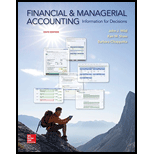
T-Account:
It is a graphic presentation of general ledger account. This account is fundamental training tool in double entry book keeping. Debit entries are shown on the left side of T-account and credits are shown to the right side of T-account.
Merchandise Inventory:
It means the materials or goods held by a business for the purpose of resale. It includes raw materials, work-in-progress and finished goods. It is reported as an asset in the asset side.
Perpetual Inventory System:
It is an inventory system wherein accounts related to inventory are updated on each purchase and sale activity. Quantities of inventory are updated on continuous basis. This can be done by integrating the inventory system to order entry and to the retail sale point of system.
Cost of Goods Sold:
Cost of goods sold means the direct cost incurred in the production of goods. It involves labor cost, material cost, direct factory
To prepare: T-Accounts for Merchandise Inventory, and Cost of Goods Sold of Company T and compute account balances for year 2015.
Want to see the full answer?
Check out a sample textbook solution
Chapter 4 Solutions
Financial and Managerial Accounting: Information for Decisions
- I need help with this general accounting question using the proper accounting approach.arrow_forwardPlease help me solve this general accounting problem with the correct financial process.arrow_forwardI need the correct answer to this general accounting problem using the standard accounting approach.arrow_forward
- Can you solve this financial accounting question with the appropriate financial analysis techniques?arrow_forwardPlease provide the answer to this general accounting question using the right approach.arrow_forwardIn the first month of operations, the total of the debit entries to the cash account for Sunway Logistics amounted to $7,200, and the total of the credit entries to the cash account amounted to $4,850. What is the balance in the cash account at the end of the month?arrow_forward

 AccountingAccountingISBN:9781337272094Author:WARREN, Carl S., Reeve, James M., Duchac, Jonathan E.Publisher:Cengage Learning,
AccountingAccountingISBN:9781337272094Author:WARREN, Carl S., Reeve, James M., Duchac, Jonathan E.Publisher:Cengage Learning, Accounting Information SystemsAccountingISBN:9781337619202Author:Hall, James A.Publisher:Cengage Learning,
Accounting Information SystemsAccountingISBN:9781337619202Author:Hall, James A.Publisher:Cengage Learning, Horngren's Cost Accounting: A Managerial Emphasis...AccountingISBN:9780134475585Author:Srikant M. Datar, Madhav V. RajanPublisher:PEARSON
Horngren's Cost Accounting: A Managerial Emphasis...AccountingISBN:9780134475585Author:Srikant M. Datar, Madhav V. RajanPublisher:PEARSON Intermediate AccountingAccountingISBN:9781259722660Author:J. David Spiceland, Mark W. Nelson, Wayne M ThomasPublisher:McGraw-Hill Education
Intermediate AccountingAccountingISBN:9781259722660Author:J. David Spiceland, Mark W. Nelson, Wayne M ThomasPublisher:McGraw-Hill Education Financial and Managerial AccountingAccountingISBN:9781259726705Author:John J Wild, Ken W. Shaw, Barbara Chiappetta Fundamental Accounting PrinciplesPublisher:McGraw-Hill Education
Financial and Managerial AccountingAccountingISBN:9781259726705Author:John J Wild, Ken W. Shaw, Barbara Chiappetta Fundamental Accounting PrinciplesPublisher:McGraw-Hill Education





